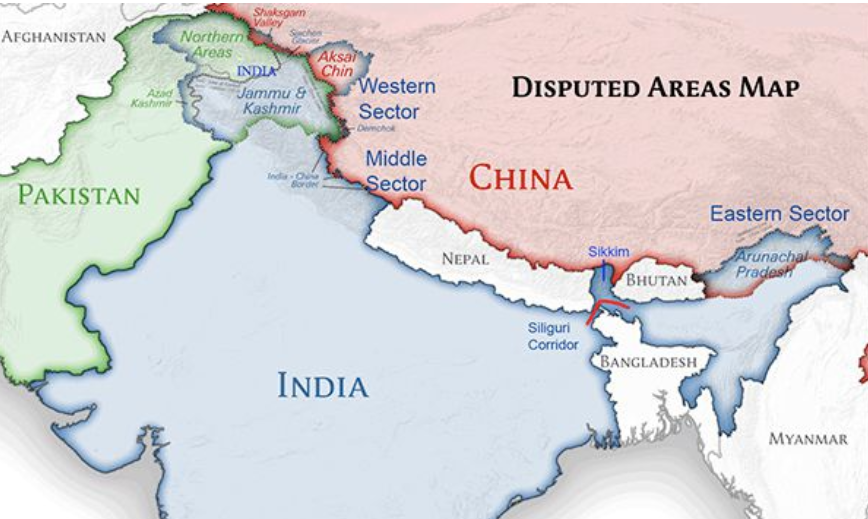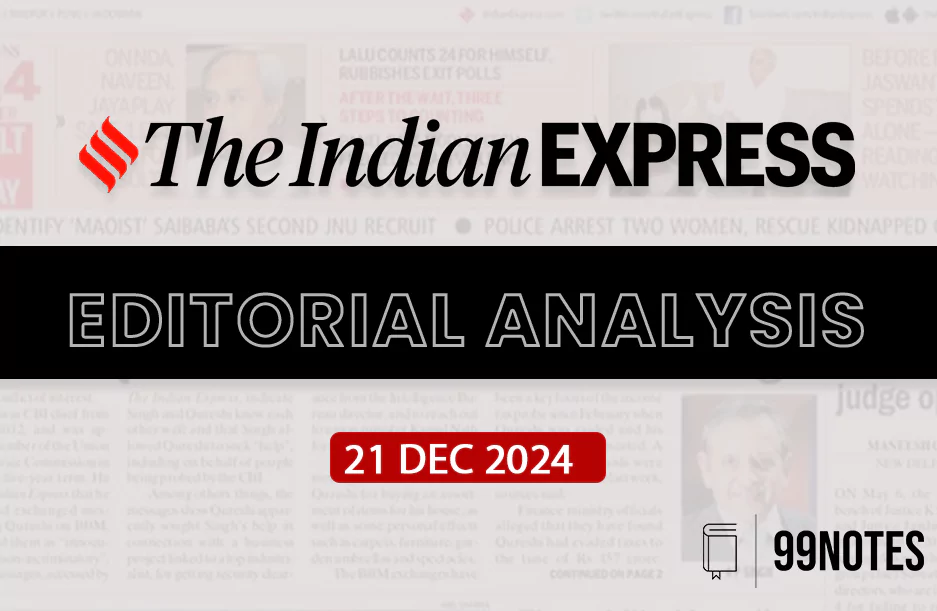21 December 2024 : Indian Express Editorial Analysis
1. Two steps forward, one step back
(Source: Indian Express; Section: The Ideas Page; Page: 11)
| Topic: GS2 – International Relations |
| Context |
|

Diverging Approaches to Diplomatic Communication
- Indian and Chinese statements regarding their bilateral relationship reveal contrasting styles and priorities.
- While India’s statements tend to be concise, China’s are more expansive, offering detailed insights into their strategic evaluations.
- This contrast provides a nuanced understanding of each side’s approach to the evolving relationship.
- The recent 23rd meeting of the Special Representatives (SRs) in Beijing underscores these differences, highlighting persistent challenges in resolving boundary issues and differing expectations for the future.
Indian Disillusionment with Boundary Negotiations
- India’s expectations of a peaceful boundary resolution have significantly diminished, driven by the prolonged process of de-escalation following the 2020 border clashes.
- The focus has shifted from long-term solutions to immediate management of friction points.
- This reflects India’s realization of China’s strategic patience and its own constrained responses. The de-escalation process appears to be proceeding at a slow pace, with limited optimism about tangible progress.
China’s Strategic Gains and Indian Limitations
- China has managed to consolidate strategic advantages through its 2020 actions, effectively advancing its position despite ongoing disengagement efforts.
- India’s lack of proportional responses to the violations has likely reassured Beijing that the Indian front is not a critical threat, allowing China to concentrate on other territorial disputes.
- The disengagement process, characterized as “two steps forward, one step back,” has left India appearing reactive rather than proactive.
Implications for Global Partnerships
- India’s cautious approach to China has broader implications for its global partnerships.
- Allies, particularly the United States under leaders like Donald Trump, may pressure India to align more closely with their strategies to counter China.
- However, India’s reluctance to confront China robustly could undermine confidence among partners facing similar challenges, signaling limited utility in reducing Chinese pressure elsewhere.
Evolution of Statements and Expectations
- An analysis of statements from the last three SR meetings since 2018 reveals a downward trajectory in India’s expectations of the bilateral relationship.
- Indian statements now focus on maintaining peace and tranquility along the border, emphasizing disengagement and operational mechanisms rather than ambitious resolutions.
- Meanwhile, Chinese statements continue to highlight their preferred consensus and guidance from leadership meetings, reflecting a more confident narrative.
Diplomatic Efforts and Missed Opportunities
- India’s continued emphasis on restoring peace and tranquility underscores its defensive posture, contrasting with China’s strategic patience.
- The apparent reluctance to directly reference existing frameworks, such as the 2005 Agreement on Political Parameters and Guiding Principles, signals a missed opportunity to hold China accountable.
- Indian diplomacy risks being perceived as reactive, oscillating between symbolic gestures and prolonged talks without substantial outcomes.
Moving Forward: Balancing Short-Term and Long-Term Goals
- The danger for India lies in repeating past patterns of easing pressure on China after temporary resolutions, as seen post-Doklam in 2017.
- Sustained political, diplomatic, military, and economic efforts are necessary to address long-term challenges.
- While informal summits may be avoided, formal exchanges should be strategically planned to ensure meaningful deliverables and progress.
The Need for Strategic Clarity
- India’s approach to China appears mired in indecision, alternating between symbolic gestures and procedural engagements without clear strategic goals.
- Addressing questions about why peace and tranquility seem to be India’s unilateral imperative could provide a clearer path forward.
- A shift from reactive to proactive diplomacy, focusing on long-term implications rather than immediate optics, is crucial to recalibrating the relationship.
| What Measures can India Adopt to Balance its Relations with China? |
|
| PYQ: ‘China is using its economic relations and positive trade surplus as tools to develop potential military power status in Asia’, In the light of this statement, discuss its impact on India as her neighbor. (150 words/10m) (UPSC CSE (M) GS-2 2017) |
| Practice Question: Discuss the evolving dynamics of India-China relations in the context of recent boundary negotiations, highlighting the challenges, strategic approaches of both nations, and their implications for regional and global diplomacy. (250 words/15 m) |
2. NYAY gone wrong
(Source: Indian Express; Section: The Editorial Page; Page: 10)
| Topic: GS2 – Social Justice |
| Context |
|
The Emergence of NYAY and its Political Journey
- The Congress party’s Nyuntam Aay Yojana (NYAY), proposed in its 2019 Lok Sabha election manifesto, envisioned providing ₹72,000 annually to the poorest 20% of Indian families.
- Despite the Congress’ defeat in 2019, the idea of unconditional cash transfers to women has found wide acceptance across India’s political spectrum.
- Within five years, 15 states governed by eight different political parties have implemented variations of NYAY, benefiting approximately 100 million women.
- This rapid adoption represents a paradigm shift in India’s welfare model, transforming an academic concept into a political reality.
Benefits of Cash Transfers: Empowerment and Economic Boost
- Proponents of cash transfer schemes argue that they empower women, especially in underdeveloped areas, by providing financial independence and improving household decision-making.
- Economists highlight their potential to stimulate consumption demand and drive economic growth.
- Additionally, cash transfers are lauded for their simplicity, efficiency, and alignment with libertarian ideals of individual freedom in financial decision-making.
- However, despite theoretical benefits, there is limited rigorous evidence to evaluate the real impact of these programs on women’s empowerment and social development.
Electoral Dynamics: A Non-Magic Bullet
- Despite widespread political adoption, cash transfers have not proven to be a game-changer in electoral politics.
- In 2019, Congress made NYAY the centerpiece of its campaign but failed to attract voter support.
- Similarly, studies from state elections, such as those in Maharashtra, show no significant difference in voting patterns between beneficiaries and non-beneficiaries of cash transfer schemes.
- This suggests that while NYAY has become an indispensable part of political manifestos, it is not an electoral magic bullet.
Financial and Political Costs of NYAY-Type Programs
- The widespread implementation of NYAY-like schemes comes with substantial financial burdens.
- Collectively, states spend nearly $25 billion annually on cash transfers to women, amounting to roughly 10% of their total revenue.
- These expenditures have contributed to rising fiscal deficits and increased debt burdens for state governments.
- Ironically, the resultant inflation and higher borrowing costs adversely affect the same poor beneficiaries these programs aim to support.
- Politically, these schemes risk reducing governance to mere financial appeasement, undermining the essence of representative democracy and holistic policymaking.
Balancing Immediate Costs with Long-Term Benefits
- While NYAY-type programs may have enormous long-term benefits in terms of social development and women’s empowerment, their short-term costs outweigh these gains.
- The financial strain on state budgets necessitates a calibrated approach to scaling such programs.
- Rapid expansion without adequate fiscal planning could jeopardize the economic stability of states, ultimately harming the very beneficiaries these schemes seek to uplift.
Risks of a Competitive “NYAY Race”
- The competitive race among political parties to outdo each other with larger cash transfer promises is a troubling trend.
- This “my NYAY is larger than yours” contest risks pushing states into deeper financial distress.
- Without proper scaling and fiscal responsibility, these schemes could exacerbate economic inequality, leaving the poorest citizens more vulnerable while wealthier sections escape unscathed during potential economic crises.
Conclusion: A Call for Prudent Implementation
- The NYAY model represents a transformative idea with the potential to uplift millions of women in the long term.
- However, its implementation must be gradual, ensuring that financial resources are managed responsibly. Policymakers should focus on measured expansion, rigorous impact evaluation, and long-term sustainability.
- While NYAY cannot be abandoned, it must not be allowed to evolve into an unsustainable financial burden, risking the economic well-being of the nation for short-term political gains.
| Practice Question: Critically analyze the impact of unconditional cash transfer schemes like NYAY on women’s empowerment, state finances, and electoral politics in India. Suggest measures for their sustainable implementation. (250 words/15 m) |


